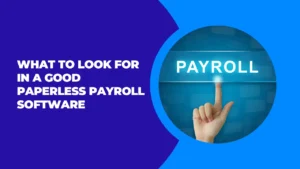Physical Address
304 North Cardinal St.
Dorchester Center, MA 02124
Physical Address
304 North Cardinal St.
Dorchester Center, MA 02124

The age of paperless solutions is upon us, and one area where digital transformation shines is payroll management. Choosing the right paperless payroll software can be daunting, given the many options available.
To help you navigate this crucial decision, this article outlines the key features and considerations you should look for when selecting a paperless payroll solution for your business.
A good paperless payroll system should be user-friendly. It’s pointless to invest in a system that your team finds complicated or challenging to use.
Look for intuitive interfaces with straightforward navigation, and ensure that the software offers simple, step-by-step guides for performing essential tasks like setting up payroll, enrolling employees, and generating reports. User experience should be at the forefront of your criteria, as this will ease the adoption process and ensure long-term usability.
For instance, the software should feature a clean dashboard that provides an overview of payroll activities at a glance, including upcoming pay periods, pending approvals, and recent transactions. Your accounting and HR departments’ productivity and efficiency will both greatly increase as a result.
The effectiveness of any software is magnified when it seamlessly integrates with your existing business systems. Choose payroll software that can easily interface with your current accounting, human resources, and time-tracking systems.
Compatibility minimizes data entry errors and ensures a more cohesive workflow across different departments. Ensure the software supports common file formats and APIs, enabling smooth data exchange without requiring significant adjustments to your existing infrastructure.
Integration with your HR software, for instance, allows for automatic updates to employee records, reducing manual data entry and the likelihood of errors. Similarly, linking with your accounting system can automate expense tracking and financial reporting, saving your accounting team valuable time and effort.
One of the most critical factors to consider is the security of the payroll software. Payroll software must abide by data protection laws like the CCPA and GDPR since it handles sensitive employee data.
Look for features like data encryption, secure access controls, and regular security audits. Moreover, make sure the software automatically updates tax tables and other compliance-related information to keep your business aligned with legislative changes.
Advanced security measures that can further improve the protection of sensitive payroll data include audit logs, role-based access controls, and multi-factor authentication.
These features not only shield your business from potential security breaches but also help ensure accountability by tracking who accessed or modified specific information.
Manual tax calculations are problematic and prone to errors, leading to costly penalties or audits. Good payroll software should automate tax calculations and filings, ensuring that you comply with federal, state, and local tax laws without the headache.
The software should keep up with the latest tax regulations and automatically incorporate changes into your payroll calculations. Automated reminders for deadlines and electronic filing options can further streamline your tax management process.
Furthermore, the software should generate accurate tax reports, including Form W-2s, 1099s, and quarterly tax filings. You should be able to readily view and export these reports to make your year-end tax preparations easier.
With these capabilities, you can minimize the risk of tax-related issues and ensure your business remains in good standing with tax authorities.
An employee self-service portal can significantly enhance the efficiency of your payroll system. With the use of this tool, employees can view their tax forms, pay stubs, and personal data without assistance from HR.
Self-service portals empower employees and save HR valuable time, which they can then spend on more strategic initiatives. Look for software that offers a secure and user-friendly self-service portal that employees can access from any device.
In addition to providing access to payroll information, the portal should allow employees to update their personal details, such as address changes or direct deposit information.
This keeps HR’s administrative workload lighter while maintaining the accuracy and timeliness of personnel records. Moreover, the portal should offer support resources, such as FAQs or chatbots, to assist employees with common queries.
Reporting capabilities are essential for analyzing payroll data and making informed business decisions. Look for software that offers customizable payroll reports, allowing you to generate detailed insights tailored to your unique needs.
Whether you need summaries on labor costs, overtime, or department-specific expenses, the right software should provide easy customization options and export capabilities.
Advanced reporting features may include the ability to schedule automated report generation and distribution to key stakeholders. This ensures that decision-makers have timely access to critical payroll data, enabling them to make proactive adjustments to labor budgets or staffing strategies.
Additionally, visual reporting tools, such as graphs and charts, can help convey complex data in an easily digestible format.
Cost is always a consideration, but it shouldn’t be the sole determinant. Evaluate pricing models carefully, whether they are subscription-based, tiered, or pay-per-use. Also, consider the software’s scalability.
As your business grows, the software should be able to accommodate additional employees and more complex payroll requirements without requiring a complete overhaul.
Look for transparent pricing structures that avoid hidden fees or unexpected costs. Consider seeking trials or demos to understand the software’s ROI better.
As your business expands, the ability to add new features or upgrade to higher service tiers can help ensure that the software continues to meet your evolving needs. Scalability is particularly critical for businesses experiencing rapid growth or those anticipating future expansion.
Selecting the right paperless payroll software is a pivotal decision that can significantly impact your organization’s efficiency, security, and compliance.
By focusing on ease of use, compatibility, security, compliance features, and other critical aspects highlighted in this article, you can make an informed choice that aligns with your business needs and goals.
Ensuring that your payroll processes are optimized and future-proofed will not only save costs but also foster a more productive and satisfied workforce.